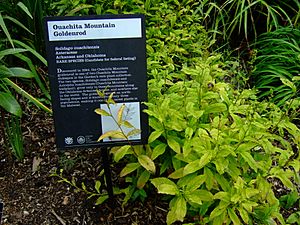Ouachita Mountain goldenrod facts for kids
Quick facts for kids Ouachita Mountain goldenrod |
|
|---|---|
 |
|
| specimen in Missouri Botanical Garden | |
| Conservation status | |
| Scientific classification | |
| Genus: |
Solidago
|
| Species: |
ouachitensis
|
Solidago ouachitensis, also known as the Ouachita Mountain goldenrod, is a special kind of flowering plant. It belongs to the aster family, which includes many well-known flowers like sunflowers and daisies. This goldenrod is quite rare. You can only find it in a small area of North America. It grows specifically in the Ouachita Mountains, which are located on the border between Arkansas and Oklahoma in the United States.
About the Ouachita Mountain Goldenrod
This plant is a perennial herb. This means it lives for more than two years. Its stems die back each winter. But its roots and a woody base, called a caudex, survive underground. New stems grow from this base every spring.
What it Looks Like
The Ouachita Mountain goldenrod can grow quite tall. It reaches up to about 1.1 meters (or 44 inches) high. It usually has one or more straight stems.
Its leaves are long and have jagged edges, like tiny teeth. These leaves are about 10 to 13 centimeters (4 to 5.2 inches) long. The biggest leaves are found in the middle of the plant. Leaves higher up on the stem are smaller.
Each plant produces many bell-shaped flower heads. There are usually between 25 and 50 flower heads on one plant. Each flower head has small yellow petals. It typically has one yellow ray floret (the petal-like part). It also has 4 to 5 disc florets (the tiny flowers in the center). This goldenrod blooms in the fall, usually in September and October.
Where it Lives
The Ouachita Mountain goldenrod is a plant that prefers cool and wet places. It is thought to be a relict species. This means it is a survivor from a time when the climate was colder and wetter.
Today, it only grows in specific spots in the Ouachita Mountains. These spots are usually wet forest habitats. They are often found on slopes that face north. North-facing slopes get less direct sunlight. This keeps them cooler and moister.
Many other plants grow alongside the Ouachita Mountain goldenrod. These include trees like Magnolia tripetala, Fagus grandifolia, Acer rubrum, and Quercus rubra. Other plants found nearby are Aesculus glabra, Asarum canadense, Campanula americana, Panax quinquefolium, Toxicodendron radicans, and Hybanthus concolor.


